
27 June 2023
Cars play a huge part in our lives, but what about their impact on our wildlife? Recent evidence has highlighted three detrimental effects of driving vehicles that harm wildlife.
Vehicle strikes and wildlife
Findings from a 2022 analysis of over 17,000 insurance claims for animal collisions in Australia revealed that around half of the population has collided with animals while driving.1
The research also highlighted that winter (June to August) is the peak season for wildlife accidents and that dusk is the most dangerous time, particularly between 4:30 and 8 pm. Wildlife collisions are more common on rural roads and frequently involve kangaroos, wallabies and koalas.
Where do most animal collisions occur in Queensland? Here are the top 5 hotspots:
- St George
- Townsville
- Roma
- Warwick
- Mareeba
Sadly, too many koalas (Phascolarctos cinereus) are hit by cars. In fact, more than 85 per cent of koalas hit by a car die.2 Koala hospital records show that about 300 koalas are killed on the roads in South East Queensland each year. Unfortunately, many more deaths go unreported.
How fuel emissions affect wildlife
Transport pollution, mainly from vehicle exhausts, harms wildlife and is Australia’s second-largest source of climate pollution. The release of airborne particles and chemical compounds from vehicle emissions poses a severe ecological threat. The particles can infiltrate the lungs of both humans and animals, leading to long-term health issues.
Moreover, these emissions can damage plants by clogging their leaves and affecting photosynthesis. Research has shown that highly urbanised areas near busy roads suffer from decreased biodiversity as nitrogen-tolerant plants replace more delicate species.3
Air pollution can affect the food supply of wildlife by entering the food chain. Once consumed, many of these pollutants collect and are stored within the animal’s tissues. As other animals eat animals along the food chain, these pollutants continue to collect and increase in concentration. This process is called bioaccumulation. Many of our top-level predators are susceptible to the bioaccumulation of these types of air pollutants.4
How roads affect wildlife
Another significant issue is the impact of roads on wildlife populations and the fragmentation of their habitats. One specific concern is the generation of dust due to vehicular movement, especially on unsealed roads.
The accumulation of dust particles on vegetation can reduce photosynthesis and impede nutrient absorption. Moreover, excessive inhalation of dust can harm the respiratory systems of wildlife.
When it rains, road sediment and dust particles can be washed into nearby rivers and creeks, reducing water quality. The dust may contain pollutants such as heavy metals, hydrocarbons, and nutrients, which can harm aquatic organisms.
Additionally, increased sedimentation can disrupt the balance of aquatic habitats, clog fish gills, and hinder light penetration, affecting the growth of plants in our waterways. Moreover, the accumulation of sediment in estuaries and coastal areas can impact coral reefs and seagrass beds.5
Roads also fragment natural habitats.
“Roads can divide ecosystems that were once connected into isolated patches,” says Wildlife Queensland’s Projects Manager Matt Cecil.
“This fragmentation restricts wildlife movement and prevents access to essential resources such as food, water, and mates.”
The loss of connectivity between habitats also affects gene flow, which limits genetic diversity and increases the vulnerability of species to environmental changes and disease.
What can we do to minimise these impacts?
- Practice safe driving habits, especially during high-risk periods, to reduce the likelihood of accidents.
- Reduce fuel emissions by using public transport or opting for electric or hybrid vehicles.
- Campaign for stricter emission standards, more wildlife crossings and fencing, and improved road design and maintenance.
In conclusion, protecting our wildlife is crucial for the preservation of biodiversity and the functioning of healthy ecosystems. By addressing these three key factors, we can work towards a future where vehicles coexist harmoniously with our wildlife.
References
- Aussie drivers admit to risky tactics to avoid wildlife collisions | Suncorp Group | Suncorp Group
- Living with wildlife – Koalas and cars (des.qld.gov.au)
- Effects of air pollution from road transport on growth and physiology of six transplanted bryophyte species – ScienceDirect
- The Effects of Air Pollution on Plants and Animals | Serendip Studio
- What is sediment and why is it a stormwater pollutant?
